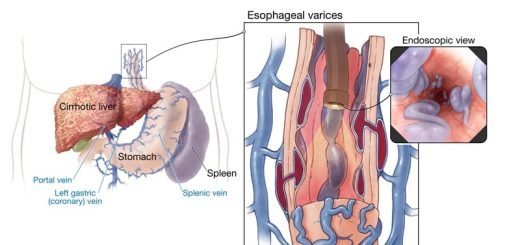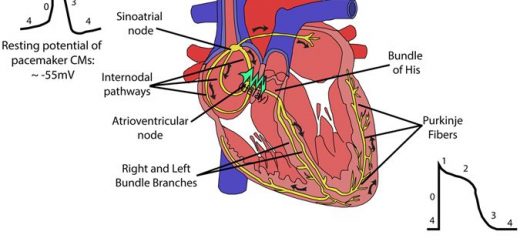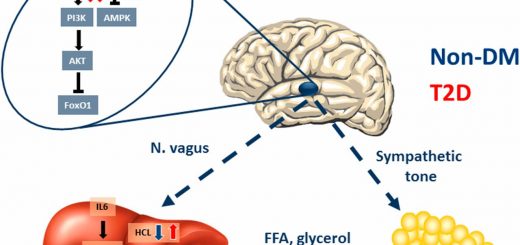Types of bones, Histological features of compact bone and cancellous bone
Bone tissue (osseous tissue) is a hard tissue, It is a type of specialised connective tissue. The bone is a rigid tissue, it constitutes part of the vertebrate skeleton in animals. Bones protect many organs of the body, they produce red and white blood cells, they store minerals, provide structure and support for the body, and enable mobility.
Types of bones
There are two types of bone which are primary bone or woven bone, and secondary bone or lamellar bone:
Primary bone or woven bone
It is the first bone to be deposited during the prenatal development of bone and during bone repair. It has the following characters:
- It is an immature weak bone due to low calcium content in the matrix.
- Irregular arrangement of collagen fibers.
- Osteocytes are numerous and irregularly-arranged.
- Temporary and is replaced later on by the secondary bone.
Secondary bone or lamellar bone
It has the following characters:
- It is a mature strong bone with high calcium content in its matrix.
- Regular arrangement of collagen fibers in the form of multiple layers or lamellae. Thus, the histological unit of this bone is the bone lamella where collagen fibers in each lamella are organised parallel to each other.
- Osteocytes are less abundant (than in woven bone). They are regularly-aligned inside their lacunae along the collagen lamellae. Their processes communicate together through the bony canaliculi.
The mature lamellar bone is microscopically-differentiated into two types:
- The compact bone.
- The cancellous bone (Spongy bone).
Histological features of compact bone
Site:
It is found in:
- The diaphysis (shaft) of long bones e.g. the humerus, femur, radius, ulna, tibia, and fibula. Here, the compact bone has a single centrally-located bone marrow cavity containing, in adult, yellow bone marrow.
- The outer and inner tables of flat bones e.g. the skull, sternum, and hip bone.
The bone coverings:
The external surface of compact bone is covered by the periosteum, while its single medullary cavity in long bones is lined by the endosteum.
The periosteum gives attachment to the tendons of muscles. At these sites, the collagen fibers are thickened forming the Sharpey’s fibers that pass to penetrate deep into the bone substance to be fixed to the external circumferential lamellae and interstitial lamellae.
The bone tissue:
In compact bone, the bone lamellae are regularly-arranged in three patterns which can be studied in cross-section of the shaft of long bone:
1- The circumferential lamellae
These are 2-3 parallel bone lamellae that encircle the whole circumference of the bone shaft. According to their localization, there are:
- The inner circumferential lamellae, which surround the central medullary cavity just beneath the endosteum.
- The outer circumferential lamellae, which lie just beneath the periosteum.
2- The Haversian systems (the osteons)
The compact bone consists mainly of several Haversian systems or osteons. The osteon is the characteristic structural unit in compact bone. Each osteon is formed of:
- A cylinder of 4-20 concentric bone lamellae of different diameters that are telescoped inside each other.
- The lamellae are concentrically-arranged around a central narrow Haversian canal that runs parallel to the long axis of the bone.
- The Haversian canal is lined by osteogenic cells and contains loose connective tissue rich in blood vessels and nerves.
- Volkmann’s canals are transverse or oblique bony canals that connect the blood vessels of Haversian canals with each other and with the blood vessels of the periosteum and the endosteum.
- Haversian and Volkmann’s canals represent the vascular channels that transport nutritive substances throughout the compact bone. However, they can be distinguished histologically from Haversian canals as they extend in an oblique or a transverse direction and not in a longitudinal direction as the Haversian canal. They are not surrounded by concentric bone lamellae; instead, they perforate the lamellae.
3- The interstitial lamellae
These are irregular groups of parallel bone lamellae filling the spaces between the Haversian systems. They represent the lamellae that are left behind from the preexisting osteons during the process of continuous remodeling of bone.
Histological features of cancellous bone
Site: It is found in:
- The epiphysis of long bones (however, the outer surface is covered by a thin layer of compact bone).
- The diploe of flat bones (the area between the outer & inner tables).
Components: Cancellous bone is formed of two main components:
1- The bone trabeculae
These are thin interconnected bone trabeculae. Each trabecula is made up of bone lamellae not arranged as osteons. The osteocytes are individually-scattered within their lacunae. Primitive Haversian systems (having few lamellae) might be present.
2- The bone marrow cavities
These are numerous cavities of variable shapes and sizes separating the bone trabeculae. They are lined by endosteum. They are lined by endosteum. They are filled with myeloid tissue i.e, active red bone marrow. In old age, the red marrow is largely-replaced by adipose tissue.
Histogenesis of Bone, Repair of Bone fractures, Steps of Bone Growth
Back muscle anatomy, types, structure, importance & names
Bones of upper limb structure, function, types & anatomy
Bone (Osseous Tissue) types, structure, function & importance
Bones function, types & structure, The skeleton & Curvature of Spine in Adults













